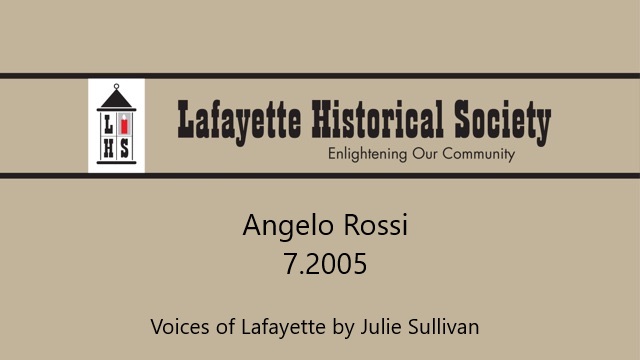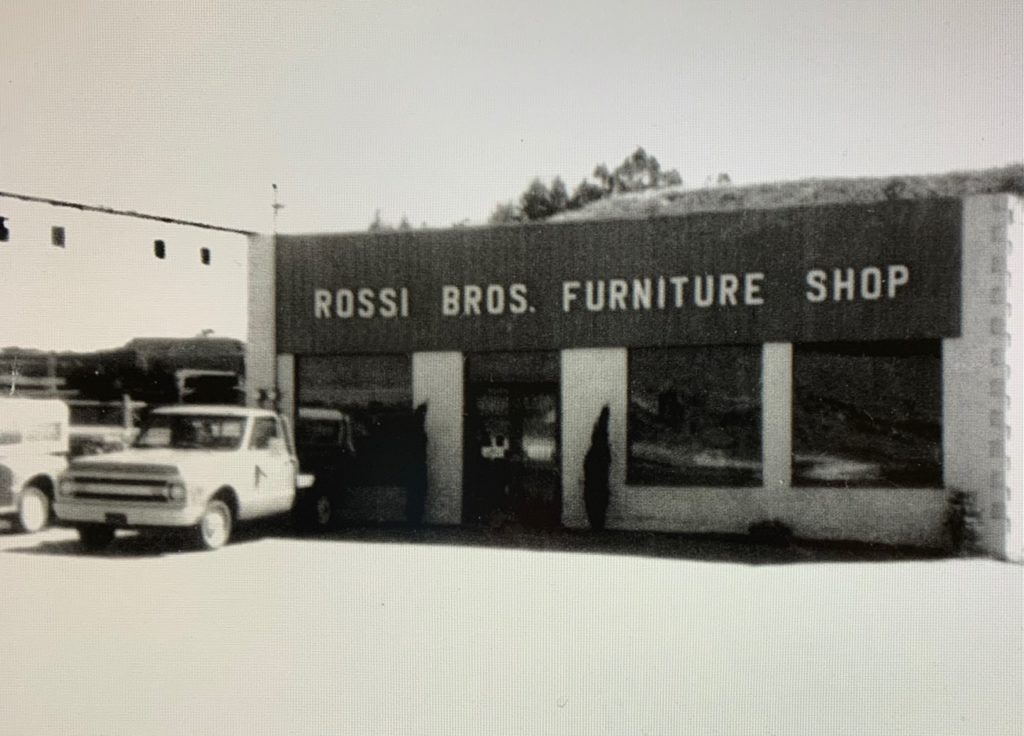Summary:
The Rossi brothers, Frank, Serafine, and Angelo, grew up on their parents’ farm on Reliez Valley Road. Each of them developed skills for woodworking and furniture making in high school, and in 1949 they opened Rossi Brothers Furniture Shop on Mount Diablo Boulevard. Their shop was located next to a lumber yard that is currently the site of the Lafayette Park Hotel. Quickly establishing a strong local reputation, they were continuously busy building new pieces of furniture and refinishing old ones for the next 30 years.
Oral History:
Rossi Brothers Furniture had its start in the shop classes at Mt. Diablo and Acalanes High Schools. That’s where Angelo Rossi and his two older brothers, Frank and Serafine, got their love of woodworking and making fine furniture. Before World War II, all three brothers worked for National Upholstery in Oakland. After the war, Angelo’s oldest brother, Frank, started making furniture in their father’s barn off Reliez Valley Road.
“Then my dad bought a lot on Mt. Diablo next to the lumber yard, and my brothers and I had a building built and opened Rossi Brothers Furniture Shop,” Angelo remembers. That was 1949.” The building adjacent to the Lafayette Park Hotel, where the shop operated for nearly 30 years, is still there.
“Frank did the carving, Serfi the framing, and I did the refinishing. We refinished and made furniture. Everybody wanted antique white. If the customer had a picture of an old piece we’d make a new one match it. When Rossmoor came in, we couldn’t do enough work,” Angelo says. “They wanted things cut down to fit when they moved from larger homes to smaller places. We never advertised except a listing in the phone book, it just built up by word of mouth. We never hired any other employees, and we lost a lot of work. We got so many chairs to repair we’d put big nails up to hang them until we got around to them. A lot of times, we couldn’t find the people who brought them in.
“One reason our business was so successful was I think we were too reasonable,” he says with a chuckle. “We found that out after we retired. The only mistake we made was when Frank picked up a baby grand piano and a desk. The piano was to be one color and the desk another. Serfi and I did most of the refinishing, and we reversed the colors. The lady liked the piano so much she left it like that, but we had to do the desk over.
“We stripped everything by hand. If you try to dip a chair, it will fall apart. We put it on a tray that would catch the remover and put the remover on with big brushes then rinsed it off with hot water. We knocked a hole in the back of the building and had a big fan there. In those days you could blow the fumes out, but nowadays you can’t do that.
“Once in a while we had a disagreement, but we all came home for lunch. I’d drop both my brothers off on Rossi Street, the next street over, and by the time I picked them up to go back to work, we’d forget all about it.
“We liked being our own boss, but it was hard work,” Angelo says. The brothers closed the business and retired in 1977. Frank has passed away, but Serafine lives in Davis, California.
Angelo and his wife, Gloria, are still living in the house they built on Angelo Street, which was named in Angelo’s honor, fifty-four years ago. Their home is a stone’s throw from the house where he was born.
Angelo’s father came to the United States from Italy in 1907. “My father was a sharecropper for the Rowland family,” Angelo explains. “ They were the first settlers in Reliez Valley, and their house is still standing off Reliez Valley Road. They took the crops over the hill in wagons to the city before there was a tunnel. Pleasant Hill Road was all gravel, and Reliez Valley Road was just a trail, actually. I have a picture of my parents dancing in the road. That would have been around the 1920’s.”
The first Rossi house had no plumbing or electricity. “My mother had to pump water from the outside and bring it in, and she wasn’t very happy with that. Later, my father bought fifty-eight acres of his own and built a house. They put water and electricity in, but he had to buy an electric stove before they would bring electricity to the house. He had a well that pumped water into a tank, and it flowed by gravity down the hill to the house,” Angelo says. Angelo’s father bought an additional ninety acres during the Great Depression. The main crops were peaches, plums and pears.
“When we went to church, we had to walk all the way to Springhill where the Martinos lived. They had a little pickup with seats on both sides in the back where the kids sat. We used to sit upstairs in the old St. Mary’s Church in Walnut Creek. That’s where California Pizza Kitchen is now.”
Angelo’s brothers attended Mt. Diablo High School, but he was in the first graduating class at Acalanes in 1940. “All us boys helped on the farm. The only sport we could go out for was track, because it’s an individual sport, and we didn’t have to go to practices.” Angelo was the first freshman to run 3.5 miles. He was drafted in 1942 and served in the Pacific in World War II, where he was wounded twice and received the Purple Heart. He and Gloria were married soon after he was discharged. They have one son and two grandchildren.
“My brothers worked in a shipyard during the war. But all three of us learned to make furniture in high school. When I was in Shop at Acalanes, we made all the mechanical drawing tables for the school.”
Angelo’s father subdivided his property after World War II. “The development was called Marydale after my mother, Mary,” Angelo explains. “My dad gave each of us boys a lot. There’s a Rossi Street, and since I was the only brother in the service, they said let’s name a street after Angelo.”
Angelo’s memories of an earlier Lafayette include Mrs. Hunt’s ice cream stand on Mt. Diablo Boulevard. “We walked back and forth in front of it after grammar school until she’d give us free ice cream. Where Handlebar Toys is now was a general store where you could buy rabbit feed or anything. For a penny you could buy candy. It was loose in these little shovels. Then next door was where the McNeils lived, and they had the hotel there, too. The Wayside Inn was the old hotel.
“When we were kids, we never went out to restaurants. There just weren’t any. There were hardly any cars around when Gloria and I first lived here on Angelo Street. We had to pick up our mail on Reliez Valley Road.
“I liked Lafayette when it got a little busier, but now it’s too busy. I guess it can’t change much now.”
Excerpted from “Voices of Lafayette” by Julie Sullivan. This book is available for purchase in the History Room.



I remember meeting Angelo Rossi when he called me out to work on his pool. I was just 16 years old and he and I would have some great conversations about the Old Lafayette when he was a kid. He told me of the story of how he was born in his parents house and how the doctor came out in a horse and buggy to deliver him on Rossi Lane. After getting to know him, I have a 100 year old family rocker that I gave to him to strip and re-glue… it took him several months to do but when it was finished my family rocker was like brand new. I still have that old rocker and it’s in great shape.